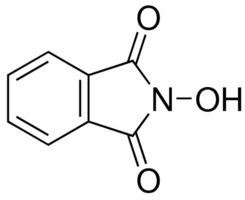 | ||
N-Hydroxyphthalimide is the N-hydroxy derivative of phthalimide. The compound is used, inter alia, as catalyst for oxidation reactions, in particular for the selective oxidation (e. g. alkanes to alcohols) with molecular oxygen under mild conditions.
Contents
Occurrence and Production
The synthesis of N-hydroxyphthalimide from phthaloyl chloride and hydroxylamine hydrochloride in the presence of sodium carbonate in aqueous solution was first reported by L. Cohn in 1880 (referred to as "Phthalylhydroxylamin”).
The reaction forms the product as red sodium salt in a basic solution from which the white form of the N-hydroxyphthalimide precipitates in 55% yield by acidification.
The reaction of diethyl phthalate with hydroxylamine hydrochloride in the presence of sodium acetate also leads to N-hydroxyphthalimide.
The reaction of phthalic anhydride with hydroxylamine hydrochloride and Na2CO3 in water at 95 °C gives N-hydroxyphthalimide as a pale yellowish needles in 95% crude yield, from which pure and colorless N-hydroxyphthalimide is obtained in 76% yield by recrystallization.
Microwave irradiation of phthalic anhydride and hydroxylamine hydrochloride in pyridine produces N-hydroxyphthalimide in 81% yield.
Even without the addition of a base, phthalic anhydride and hydroxylamine phosphate react to give N-hydroxyphthalimide when heated to 130 °C 86% yield.
Properties
N-Hydroxyphthalimide is a colorless to yellow, odorless crystalline powder which is soluble in water and organic solvents such as acetic acid, ethyl acetate and acetonitrile. The compound exists in two different-colored monoclinic crystal forms. In case of the colorless white form, the N-OH group is rotated about 1.19° from the molecular plane, while in the yellow form it is only about 0.06° rotated.
The color of the synthesized N-hydroxyphthalimide depends on the type of solvent used; the color transition from white to yellow is irreversible. N-hydroxyphthalimide forms strongly colored, mostly yellow or red salts with alkali and heavy metals, ammonia and amines. Hydrolysis of N-hydroxyphthalimide by the addition of strong bases produces phthalic acid monohydroxamic acid. N-hydroxyphthalimide ethers, on the other hand, are colorless and provide O-alkylhydroxylamines by alkaline hydrolysis or cleavage through hydrazine hydrate.
Since N-hydroxyphthalimide has been described 1880 as "phthalylhydroxylamine", the molecular structure was discussed between phthalic anhydride monooxime ("phthaloxime") (I), 2,3-benzoxazine-1,4-dione (II), and N-hydroxyphthalimide and was decided in favor of N-hydroxphthalimide (III) just during the mid-1950s by analysis of reaction products.
Applications
Just like with N-hydroxysuccinimide (HOSu), N-hydroxyphthalimide allows upon elimination of water the formation of so-called active esters (e. g. from carboxylic acids and a carbodiimide such as dicyclohexylcarbodiimide).
However, this method has not found widespread acceptance due to the higher water solubility and reactivity of HOSu esters.
Esters of N-hydroxyphthalimide and activated sulfonic acids such as trifluoromethanesulfonic anhydride or p-toluenesulfonyl chloride are used as so-called photoacids, which split off protons during UV irradiation.
The protons generated serve for the targeted local degradation of acid-sensitive photoresists.
N-hydroxyphthalimide can be converted with vinyl acetate in the presence of palladium(II)acetate to the N-vinyloxyphthalimide, which is quantitatively hydrogenated to N-ethoxyphthalimide and after purified by cleavage, yielding O-ethylhydroxylamine.
A variety of different functional groups can be oxidized with the nitroxide radical (phthalimide-N-oxyl, PINO) formed by the abstraction of a hydrogen atom from N-hydroxyphthalimide under gentle conditions (similar to the piperidine derivative 2,2,6,6-tetramethylpiperidinyloxyl (TEMPO)):
Using molecular oxygen alkanes can be oxidized to form alcohols, secondary alcohols to ketones, acetals to esters and alkenes to epoxides. Amides can be converted into carbonyl compounds with N-hydroxyphthalimide and cobalt(II)salts under mild conditions.
Efficient oxidation reactions of precursors of important basic chemicals are of particular technical interest. For example, ε-caprolactam can be prepared using NHPI from the so-called KA oil ("ketone-alcohol" oil, a mixture of cyclohexanol and cyclohexanone) which is obtained during the oxidation of cyclohexane. The reaction proceeds via cyclohexanol hydroperoxide which reacts with ammonia to give peroxydicyclohexylamine followed by a rearrangement in the presence of catalytic amounts of lithium chloride.
The use of N-hydroxyphthalimide as a catalyst in the oxidation of KA oil avoids the formation of the undesirable by-product ammonium sulfate which is produced by the conventional ε-caprolactam synthesis (Beckmann rearrangement of cyclohexanone oxime with sulfuric acid).
Alkanes are converted into nitroalkanes in the presence of nitrogen dioxide.
Cyclohexane is converted at 70 °C with nitrogen dioxide/air into a mixture of nitrocyclohexane (70%), cyclohexyl nitrate (7%) and cyclohexanol (5%).
Furthermore, applications of N-hydroxyphthalimide as oxidizing agents in photographic developers and as charge control agents in toners have been described in the patent literature.
